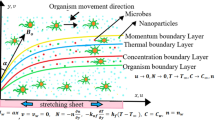Abstract
Dielectrophoresis (DEP) allows to moving neutral or charged particles in liquids by supplying a non-uniform electric field. When using alternating current and insulated electrodes, this is possible in conducting media such as aqueous solutions. However, relatively high field strength is required that is discussed to induce also an undesired Joule heating effect. In this paper, we demonstrate boundary conditions for avoiding this side effect and suggest a novel design of an interdigitated electrode (IDE) configuration to reduce the power consumption. Numerical simulation using OpenFOAM demonstrated that, when replacing conventional plate IDE by cylindrical micro-IDE in microchannel systems, the dielectrophoretic force field, i.e., the electric field gradient squared, becomes stronger and more homogeneously distributed along the electrodes array. Also the resulting particle DEP velocities were highest for the cylindrical IDE. The simulations were experimentally confirmed by measuring velocity of resin particle located at the subsurface of demineralized water. Surprisingly the fluid flow induced by electrothermal effect turned out to be negligible in microchannels when compared to the DEP effect and becomes dominant only for distances between particle and IDE larger than 6,000 μm. The well-agreed experimental and simulation results allow for predicting particle motion. This can be expected to pave the way for designing DEP microchannel separators with high throughput and low energy consumption.










Similar content being viewed by others
Abbreviations
- AC:
-
Alternative current
- CCD:
-
Charge-coupled device
- CFD:
-
Computational fluid dynamics
- DC:
-
Direct current
- DEP:
-
Dielectrophoresis
- eff:
-
Effective
- ETE:
-
Electrothermal effect
- EFG:
-
Electric field gradient squared
- F DEP :
-
Dielectrophoretic force
- IDE:
-
Interdigitated electrode configuration
- nDEP:
-
Negative DEP
- pDEP:
-
Positive DEP
- \({\text{re}}[\tilde{K}]\) :
-
Real part of the Clausius–Mossotti factor
- rms:
-
Root mean squared
References
Baune M, Du F, Thöming J (2008) Dielectrophoresis-Bridging the scale in modeling and applicaiton. Logos Verlag Berlin GmbH, Berlin
Cao J, Cheng P, Hong F (2008) A numerical analysis of forces imposed on particles in conventional dielectrophoresis in microchannels with interdigitated electrodes. J Electrostat 66:620–626
Castellanos A, Ramos A, Gonzalez A, Green NG, Morgan H (2003) Electrohydrodynamics and dielectrophoresis in microsystems: scaling laws. J Phys D Appl Phys 36:2584–2597
Cetin B, Li D (2011) Dielectrophoresis in microfluidics technology. Electrophoresis 32:2410–2427
Crews N, Darabi J, Voglewede P, Guo F, Bayoumi A (2007) An analysis of interdigitated electrode geometry for dielectrophoretic particle transport in micro-fluidics. Sensors Actuators B 125:672–679
Du F, Baune M, Thöming J (2007) Insulator-based dielectrophoresis in viscous media—simulation of particle and droplet velocity. J Electrostat 65:452–458
Du F, Baune M, Thöming J (2008) Dielectrophoretic gold particle separation. Sep Sci Technol 43(15):3842–3855
Du F, Hawari A, Baune M, Thöming J (2009) Dielectrophoretically intensified cross-flow membrane filtration. J Membr Sci 336:71–78
Du F, Ciaciuch P, Bohlen S, Wang Y, Baune M, Thöming J (2013) Intensification of cross-flow membrane filtration using dielectrophoresis with a novel electrode configuration. J Membr Sci 448:256–261
Green NG, Morgan H, Milner JJ (1997) Manipulation and trapping of sub-micron bioparticles using dielectrophoresis. J Biochem Biophys Methods 35:89–102
Green NG, Ramos A, Morgan H (2002) Numerical solution of the dielectrophoretic and travelling wave forces for interdigitated electrode arrays using the finite element method. J Electrostat 56:235–254
Jones TB (1995) Electromechanics of particles. Cambridge University Press, USA
Khoshmanesh K, Nahavandi S, Baravandi S, Baratchi S, Mitchell A, Kalantar-zadeh K (2011) Dielectrophoretic platforms for bio-microfluidic systems. Biosens Bioelectron 26:1800–1814
Kumar A, Williams SJ, Wereley ST (2009) Experiments on opto-electrically generated microfluidic vortices. Microfluid Nanofluid 6:637–646
Li X, Chin E, Sun H, Kurup P, Gu Z (2010) Fabrication and integration of metal oxide nanowire sensors using dielectrophoretic assembly and improved post-assembly processing. Sensors Actuators B Chem 148:404–412
Morgan H, Green NG (2003) AC electrokinetics: colloid and nanoparticles. Research Studies Press, England
Morganti E, Collini C, Cunaccia R, Gianfelice A, Odorizi L, Adami A, Lorenzelli L, Jacchetti E, Podesta A, Lenardi C, Milani P (2011) A dielectrophoresis-based microdevice coated with nanostructured TiO2 for separation of particles and cells. Microfluid Nanofluid 10:1211–1221
Pethig R (2010) Review article—dielectrophoresis: status of the theory technology, and applications. Biomicrofluidics 4:022811
Pethig R, Markx GH (1997) Applications of dielectrophoresis in biotechnology. TIBTECH 15:426
Pohl HA (1978) Dielectrophoresis: the behavior of neutral matter in nonuniform Electric Fields. Cambridge University Press, London
Ramos A, Morgan H, Green NG, Castellanos A (1998) AC electrokinetics: a review of forces in microelectrode structures. J Phys D Appl Phys 31:2340–2353
Sano N, Matsukura B, Ikeyama Y, Tamon H (2012) Dielectrophoretic particle separator using mesh stacked electrodes and simplified model for multistage separation. Chem Eng Sci 84:345–350
Srivastava SK, Baylon-Cardiel JL, Lapizco-Encinas BH, Minerick AR (2011) A continuous DC-insulator dielectrophoretic sorter of microparticles. J Chromatogr A 1218(13):1780–1789
Thöming J, Du F, Baune M (2006) Dielectrophoretic separation of oil-water-solid dispersions—selectivity and particle velocity. Fresenius Environ Bull 15(7):687–691
Visser DC, Houkema M, Siccama NB, Komen EMJ (2012) Validation of a FLUENT CFD model for hydrogen distribution in a containment. Nucl Eng Des 245:161–171
Weiss B, Hilber W, Gittler P, Jakoby B (2009) Particle separation in alternating-current electro-osmotic micropumps using field-flow fractionation. Microfluid Nanofluid 7:191–203
Acknowledgments
The authors wish to acknowledge German Research Foundation (DFG) for financial support (TH 893/9-1), and Yan Wang thanks China Scholarship Committee (CSC) for financially supporting his contribution.
Author information
Authors and Affiliations
Corresponding author
Rights and permissions
About this article
Cite this article
Wang, Y., Du, F., Baune, M. et al. Dielectrophoresis in aqueous suspension: impact of electrode configuration. Microfluid Nanofluid 17, 499–507 (2014). https://doi.org/10.1007/s10404-013-1320-8
Received:
Accepted:
Published:
Issue Date:
DOI: https://doi.org/10.1007/s10404-013-1320-8




